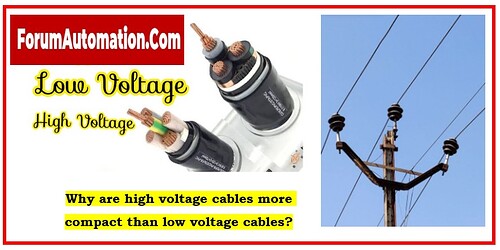Due to a number of engineering factors and principles about electrical transmission and insulation, high voltage cables frequently have smaller diameters than low voltage cables. These are some reasoning for why it is so:
1). Electrical Stress and Insulation
2). The Corona Effect
3). Dielectric Materials
4). Heat Dissipation
5). Skin Effect
6). Economic and Practical Objectives
1). Electrical Stress and Insulation
The strength of the electrical field within the wire insulation becomes increasingly significant at higher voltages. The stress on the insulating materials is decreased by smaller cables because they shorten the distance which the electric field must transmit. This permits the use of insulation that is thinner while yet providing appropriate insulating performance.
2). The Corona Effect
At specific voltage levels, a phenomenon known as corona discharge can occur in high voltage cables. The air around the wire is ionized by a corona discharge as a result of the intense electric field. Energy loss & increased radio interference may result from it. By weakening the electric field around the wire, smaller cables lessen the corona effect.
3). Dielectric Materials
There is a maximum electrical field strength that insulation materials utilized in cables can withstand before failing. It is possible to maintain the necessary insulation strength while employing a smaller cable diameter by utilizing higher quality insulation materials & reducing the size of the cable.
4). Heat Dissipation
For the same amount of electricity to be transmitted, high voltage cables frequently have low current levels than low voltage cables. This is because voltage, current, & power are related (P = VI).
Lower currents allow for the utilization of smaller conductors & as a result, lower cable sizes because less heat is produced inside the cable.
5). Skin Effect
The skin effect is apparent at higher frequencies. Due to this phenomenon, the effective cross-sectional area for current flow is decreased as alternating current condenses close to the conductor’s surface. High voltage cables may need to be constructed with the skin effect considered because they frequently transport electricity at high voltages & possibly high frequencies. This could lead to reduced conductor sizes.
6). Economic and Practical Objectives
Because smaller cables use less material, high voltage transmission is more cost-effective. Smaller cables are also simpler to install and manage, which can lower the cost of installation and upkeep.
Summary
It’s important to keep in consideration that while designing cables, especially high voltage ones, a number of criteria, including safety, electrical performance, insulation integrity, heat dissipation and cost, must be carefully balanced. In order to provide effective and dependable power transmission, these characteristics were optimized, leading to the selection to employ smaller cables for the high voltage transmission.
